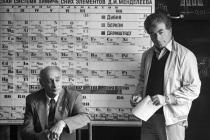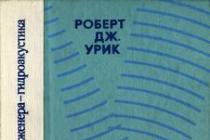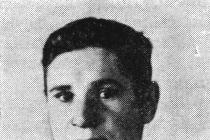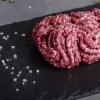[R. 17 Feb (March 2) 1913] - owls. physicist, corresponding member USSR Academy of Sciences (since 1953). Member CPSU since 1955. Upon graduation in 1938 Len. industrial institute worked in Leningrad. physico-technical institute, and since 1944 in other institutions of the USSR Academy of Sciences. Basic F.'s works are devoted to the physics of the atomic nucleus and cosmic physics. rays. He studied the dependence of the radiative capture cross sections of slow neutrons on their energy.
In 1940, in joint work with L.I. Rusinov, he showed that secondary neutrons are emitted during nuclear fission.
In the same year, joint with K. A. Petrzhak he discovered the phenomenon of spontaneous fission of heavy nuclei (Stalin Prize 1946). Discovered nuclear fission under the influence of the neutral component of cosmic radiation. rays. Works: Absorption of slow neutrons by cadmium and mercury, "Journal of Experimental and Theoretical Physics", 1939, vol. 9, no. 2; Spontaneous fission of uranium, ibid., 1940, vol. 10, issue. 9-10 (jointly with K. A. Petrzhak);
Experiments on the fission of uranium, "Izvestia of the USSR Academy of Sciences. Physical series", 1940, vol. 4, No. 2 (jointly with L. I. Rusinov);
On the spontaneous fission of thorium, "Reports of the USSR Academy of Sciences", 1941, vol. 30, No. 8 (jointly with I. S. Panasyuk);
The use of radioactive radiation in the exploration and development of oil fields in the USSR, M., 1955 (together with F. A. Alekseev);
On the spontaneous fission of thorium. [Letter to the editor], "Journal of Experimental and Theoretical Physics", 1955, v. 28, no. 4 (jointly with others). Flerov, Georgy Nikolaevich (b. 2.III.1913) - Soviet experimental physicist, academician (1968; corresponding member 1953). R. in Rostov-on-Don. He graduated from the Leningrad Polytechnic Institute (1938) and began working in the laboratory of I.V. Kurchatov at the Leningrad Physico-Technical Institute. In 1943-60, head of the sector of the Institute of Atomic Energy named after. I. V. Kurchatova, since 1960 - Director of the Laboratory of Nuclear Reactions of the Joint Institute for Nuclear Research (Dubna). The works relate to nuclear physics, nuclear energy, and cosmic ray physics. In 1940, together with K. A. Petrzhak, he discovered a new type of radioactive transformation - the spontaneous fission of uranium nuclei; with L. I. Rusinov he proved (1939) that during the fission of uranium nuclei more than two secondary neutrons are emitted.
From the end of 1942, when work on the atomic problem began in the Soviet Union, Flerov was in a group of physicists led by I.V. Kurchatov, which began the analysis and development of the entire complex of this problem.
He took an active part in creating the foundations of nuclear energy, in particular, he studied the dependence of the cross sections for the radiative capture of slow neutrons on their energy.
In the post-war years, he continued to work on the physics of nuclear fission, carried out a number of experiments on the study of cosmic rays, used nuclear physics methods in geological exploration, in particular improved (1951) neutron logging methods, and carried out extensive work on the application of nuclear physics methods in the national economy.
Since 1953, he began research in a new direction of nuclear physics - in the field of synthesis of new transuranium elements: he developed methods for the production and acceleration of multiply charged heavy ions, created sources of such ions and improved the heavy ion accelerator, developed physicochemical methods for the rapid isolation of unknown reaction products and their identification, especially in spontaneous division.
Together with his colleagues, he synthesized a number of new isotopes of trans-fermium elements with serial numbers 102, 103, 104, 105, 106 and 107, and studied their physical and chemical properties.
For the synthesis and study of the properties of transuranium elements, Flerov was awarded the Lenin Prize in 1967.
Together with his colleagues, he discovered a new type of nuclear isomerism - spontaneously fissile isomers, delayed (after beta decay) fission, the phenomenon of emission of delayed protons, and conducted experiments with isotopes overloaded with neutrons.
In 1971 he first accelerated xenon ions in a system of two cyclotrons.
Explores the possibility of the existence of superheavy elements, conducts searches for superheavy elements in natural conditions and experiments on their synthesis in reactions with heavy ions.
USSR State Prizes (1946, 1949, 1975). Hero of Socialist Labor (1949). Works: Synthesis and search for transuranium elements. - M., Knowledge, 1972. Lit.: UFN, 1973, vol. 109, issue. 4; Development of physics in the USSR. - M., Nauka, 1967, 2 books. Flerov, Georgy Nikolaevich (2.III.1913-19.XI.1990) Sov. physicist, academician USSR Academy of Sciences (since 1968). R. in Rostov-on-Don. Graduated from the Leningrad Polytechnic Institute (1938). In 1938-1941 he worked at the Leningrad Physics and Technology. institute under the leadership of I.V. Kurchatov.
In 1941 -1942 in the Soviet Union. Army. In 1942-1943 he worked at Physics and Technology. Institute in Kazan, in 1943-1957 - at the Institute of Atomic Energy.
Since 1957, Director of the Laboratory of Nuclear Reactions of the Joint Institute for Nuclear Research (Dubna). Since 1988, honorary director.
Scientific works relate to nuclear physics and nuclear chemistry. Joint with K. A. Petrzhak discovered (1940) the spontaneous fission of uranium-238 nuclei. Under his leadership, methods were developed and equipment was created for neutron and gamma ray logging of oil reservoirs (1951). Since 1953, he led the work in our country on the synthesis of new heavy transuranium elements. As a result, ale was synthesized. with serial numbers 102-107. Using the express method developed in 1958 for identifying short-lived products of nuclear reactions, the chemical properties of the elements were assessed. No. 104 - kurchatovia (synthesized in 1964) and element No. 105 - nilsborium (synthesized in 1970). At the Laboratory of Nuclear Systems, experiments were carried out on the synthesis of hypothetical transuranium elements. with large serial numbers and attempts were made to search for such elements. (for example, element. No. 114) in nature.
Joint et al. discovered (1962) the spontaneous fission of atomic nuclei from an excited state.
Hero of Socialist Labor (1949). Lenin Prize (1967), State. USSR Prize (1946, 1949, 1975). Flerov, Georgy Nikolaevich Rod. 1913, d. 1990. Physicist, specialist in nuclear physics.
In 1940 he discovered the spontaneous fission of heavy nuclei (together with K. A. Petrzhak).
He was engaged in research on the synthesis of superheavy elements at the accelerator of multiply charged ions, etc. Hero of Socialist Labor (1949). Three times laureate of the USSR State Prize (1946, 1949, 1975), Lenin Prize (1967). Full member of the USSR Academy of Sciences (1968).
Academician Georgy Nikolaevich Flerov belongs to the galaxy of founders of nuclear physics in the Soviet Union. His scientific activity is inextricably linked with the formation of the nuclear industry, with the creation of new original scientific directions, with major discoveries in the field of nuclear fission, the synthesis of new chemical elements, and new types of radioactivity.
The exceptional talent of an experimental physicist, amazing intuition, courage in setting super-tasks, a keen critical approach, the ability to clearly analyze a set of complex experimental facts, a deep understanding of the essence of physical phenomena, extraordinary energy and the ability to bring his plans to completion, and civic responsibility characterize him as our outstanding scientist time, who made a huge contribution to Russian science.
G.N. Flerov was born on March 2, 1913 in Rostov-on-Don. Having started his working life as a worker, after studying at the Leningrad Polytechnic Institute (1933-1938), he worked at the Leningrad Physico-Technical Institute under the leadership of I.V. Kurchatov. Experimental nuclear physics became his lifelong vocation. During this period, when many were concerned about the fundamental possibility of a nuclear chain reaction, G.N. Flerov, together with L.I. Rusinov, in 1938. undertake an experiment in which they tried to obtain a chain process of fission of uranium nuclei. The experiment yielded important results in determining the key parameter of the chain reaction - the number of secondary neutrons produced during the fission of uranium nuclei. This experiment was the beginning of Flerov’s great work on studying the fission of atomic nuclei.
In 1940 G.N. Flerov and K.A. Petrzhak made a fundamental discovery - the spontaneous fission of uranium. It was the starting point for the new field of nuclear physics. The work was awarded the State Prize of the first degree (1946). In the very first days of the Great Patriotic War, G.N. Flerov joined the Leningrad militia, then was sent as a student to the Air Force Academy. And here he does not stop thinking about the problems associated with nuclear fission, with the possibility of creating, during the harsh years of war, new formidable weapons necessary to defeat fascism. G.N. Flerov appeals to the USSR Academy of Sciences with a request to give him the opportunity to speak to specialists.
At the end of December 1941, he spoke to academicians A.F. Ioffe, P.L. Kapitsa and other physicists with a report on the need to study nuclear chain reactions using fast neutrons. In the report, he points out specific ways to solve a number of key problems. Without stopping there, he writes 2 letters to I.V. Stalin, in which he convincingly proves the possibility and necessity of creating an atomic bomb. These letters served as an impetus for the Soviet leadership to launch targeted research. And this at a time when the question was about life or death of the Soviet state!
Since the end of 1942, work on nuclear physics and technology began to develop rapidly, and Flerov was among the first physicists with whom I.V. Kurchatov analyzed and developed the entire complex of problems. Georgy Nikolaevich takes an active part in these works. Their result was the creation of nuclear weapons and nuclear energy in the Soviet Union. How the situation in world politics and indeed in the life of the world community has changed as a result of the emergence of the nuclear factor is well known. The merits of G.N. Flerov were highly appreciated.
In 1949 he is awarded the title of Hero of Socialist Labor and a State Prize. In 1953 he was elected corresponding member of the USSR Academy of Sciences.
Since 1953, Georgy Nikolaevich's scientific interests have been mainly related to the development of a new direction in nuclear physics - the study of processes occurring during the collision of complex nuclei, and the fundamental problem of the synthesis of new chemical elements. Work began on creating a powerful source of multiply charged ions, and in 1955, at the Institute of Atomic Energy, at the 150-cm cyclotron, for the first time in the world, intense monoenergetic beams of carbon, nitrogen and oxygen ions with an energy exceeding the Coulomb barrier of the nuclei of the heaviest elements were obtained. The first experiments carried out by G.N. Flerov with a small team of young physicists showed the unique capabilities of nuclear reactions caused by heavy ions for research in a variety of fields.
In 1955-1959. A series of studies was carried out to clarify the main features of reactions between complex nuclei. These works were the starting point for further research both in our country and abroad. The successes of the new direction attracted a lot of attention. At the suggestion and with the active support of Academician I.V. Kurchatov, it was decided to expand the scope of research on heavy ion beams and create the U-300 cyclotron, unique at that time.
For these purposes, at the Joint Institute for Nuclear Research in 1957. The Laboratory of Nuclear Reactions (NLNR) was created. Its leader until the last days of his life (1990) was G.N. Flerov. The creation of such a laboratory in an international scientific center made it possible to attract nuclear physicists from many countries to the new field of research and provide specialists with the best experimental base in the world. With the creation of the new laboratory, there was a transition from individual pioneering experiments at the IAE cyclotron to systematic fundamental research, which has been carried out at the JINR Laboratory of Nuclear Reactions by a large international team for more than 40 years. The choice of a cyclotron as a heavy ion accelerator was a fundamentally important decision.
At that time, it was believed that linear accelerators were more promising, and American physicists followed this path. But true to his intuition, G.N. Flerov preferred the cyclotron option, and life proved him right. World practice in creating heavy ion accelerators has shown significant advantages of cyclic accelerators. FLNR has remained at the forefront all these years, developing and improving its accelerator complex.
Currently there are 4 accelerators in the Laboratory. For the first time, such original solutions as the transition to azimuthal variation of the magnetic field, beam extraction by stripping ions, axial injection, connecting two cyclotrons in tandem, and acceleration of radioactive nuclei were implemented. A bright page in the scientific work of G.N. Flerov was the work on the synthesis of new chemical elements of the Periodic Table of D.I. Mendeleev. These studies are not only of great scientific significance, since they provide an idea of the nuclear stability of superheavy elements, but also demonstrate the high skill of experimenters using the most advanced achievements of high technology, reflecting the level of technical culture of the country in which such scientific research is carried out. Therefore, they are also a subject of national prestige. This explains the intense competition for discovery priorities and increased public attention to advances in this area. Synthesis experiments are extremely difficult.
Suffice it to say that the identification of a new element is carried out from a few atoms against the background of nuclear events that are 108 - 1012 times greater than the desired effect. At the same time, the physical and chemical properties of the new element are unknown; only more or less reasonable assumptions can be made about them.
Under the leadership of G.N. Flerov, FLNR developed methods for identifying new elements that were record-breaking in their sensitivity and selectivity. They included the development of rapid mechanical, gas and electromagnetic transport of nuclear reaction products from the target to detector systems, fast mass spectrometric analysis, gas chemistry, etc. Original semiconductor and solid-state low-background detector systems were developed. Multifunctional experimental installations were created that made it possible to identify the effect using many nuclear physical parameters.
02.03.1913 - 19.11.1990
In 1938 he graduated from the Faculty of Engineering and Physics of the Leningrad Polytechnic Institute, whose dean was A.F. Ioffe, and went to work at the Leningrad Institute of Physics and Technology in the laboratory of I.V. Kurchatova.
In 1939, together with L.I. Rusinov proved that during the fission of uranium nuclei, more than two secondary neutrons are emitted.
In 1940, together with K.A. Petrzak discovered the spontaneous fission of uranium nuclei.
In the first days of the war G.N. Flerov joined the militia, but was soon drafted into the army and sent to Yoshkar-Ola as a student at the Air Force Academy. After graduating from the academy, he was sent to the front.
In 1941-1942. G.N. Flerov addressed letters to I.V. Kurchatov, S.V. Kaftanov and I.V. Stalin, in which he called on the government and scientists to resume work on the uranium problem and the creation of an atomic bomb, interrupted by the war.
In 1943 G.N. Flerov was recalled from the front and included in a group of scientists involved in the creation of Soviet nuclear weapons.
In 1943-1960. G.N. Flerov worked at Laboratory No. 2 of the USSR Academy of Sciences (I.V. Kurchatov Institute of Atomic Energy).
G.N. Flerov determined the cross section for the interaction of slow neutrons with various materials, the critical masses of uranium-235 and plutonium.
In 1949 G.N. Flerov took part in testing the first atomic bomb in the USSR.
In the early 1950s. G.N. Flerov began to develop a new direction in nuclear physics - the synthesis of superheavy elements of the periodic table and achieved outstanding results in this area. Under his leadership, experiments on the synthesis of elements from 102 to 107 were successfully carried out, new physical phenomena were discovered: accelerated spontaneous fission of isomer nuclei, delayed nuclear fission, decay of nuclei with the emission of delayed protons, a new class of nuclear reactions - elastic-inelastic nucleon transfer reactions, discovered relatively high stability with respect to spontaneous fission of extremely heavy nuclei with atomic number greater than 104.
In 1960-1990 G.N. Flerov is the director of the Laboratory of Nuclear Reactions (NLNR) of the Joint Institute for Nuclear Research (JINR, Dubna). Currently, FLNR JINR is named after G.N. Flerov.
G.N. Flerov paid a lot of attention to the practical application of the achievements of nuclear physics, was one of the initiators of the development of nuclear physical methods for oil exploration and rational development of oil fields, he proposed and developed an original pulsed method of neutron and gamma-ray logging of oil reservoirs.
In 1953 he was elected a corresponding member, and in 1968 - a full member of the USSR Academy of Sciences. G.N. Flerov was a member of the Commission on Nuclear Physics of the USSR Academy of Sciences, the Scientific Council of the USSR Academy of Sciences on Radiochemistry and the Scientific Council of the USSR Academy of Sciences on the physics of the atomic nucleus.
He was a member of the editorial board of the journal “Physics of Elementary Particles and the Atomic Nucleus”.
In 1987 he was awarded the Gold Medal. DI. Mendeleev Academy of Sciences of the USSR for a series of works on the synthesis and study of the properties of new transactinide elements of the table D.I. Mendeleev, in 1989 – Gold Medal named after. I.V. Kurchatov for a series of works on the synthesis and study of the stability of the heaviest elements using intense ion beams.
G.N. Flerov was an honorary member of the Royal Danish Academy of Sciences and a member of the German Academy of Naturalists "Leopoldina" (German Democratic Republic).
One hundred years ago, on March 2, 1913, Georgy Nikolaevich Flerov, one of the greatest nuclear physicists of the 20th century, co-author of the first Soviet atomic bomb and the discoveries of a number of new elements, was born.
A common legend about Flerov says that it was he who managed to convince Stalin to begin work on the military use of atomic energy. However, after creating the bomb, Flerov took up completely different things in science, and there was no contradiction in this.
Fiztekhov's nest chick
Flerov was an enthusiast of nuclear physics. In the 30s, he worked at the Leningrad Institute of Physics and Technology, the domain of Academician A.F. Ioffe, known for the fact that during the interwar period the flower of Soviet physics worked there.
Before the war, a huge number of different scientists passed through the Physics and Technology Institute - from Lev Landau, crowned with all laurels, to Georgy Gamow, who fled to the West. Each is a bright personality and an excellent specialist. By the way, throughout its history, Physics and Technology has raised three Nobel laureates: Landau, Nikolai Semenov and, in another generation, Zhores Alferov.
And most importantly, the Physics and Technology team formed the personnel core of the Soviet nuclear project. Project manager Igor Kurchatov, his deputy Anatoly Alexandrov, “bomb physicist” Georgy Flerov, chief designer Yuli Khariton, “explosive maker” Yakov Zeldovich - all of them paid tribute to the Leningrad Center for Nuclear Physics in the interwar period.
But the war began, and theorists moved on to actual practice. Kurchatov and Aleksandrov, for example, even before the war were dealing with the problem of protection against magnetic sea mines, and now they have completely switched to this task. And Georgy Flerov went to the military registration and enlistment office to enroll in the militia.
There, according to his recollections, they assessed his “baggage” and refused. They will kill you there, so let us first teach you something. Then, in principle, they will kill you anyway, but not immediately and with any benefit to the cause. So Georgy Flerov became a junior technician-lieutenant of the Air Force, a specialist in servicing on-board equipment of combat aircraft.
Interest in physics, however, did not disappear. Moreover, the problem of nuclear chain reactions gnawed at the restless Flerov from the inside and forced him to look for solutions. At some point, he was so impressed by the scale of the problem that he began to write letters to authorities, proving the importance of work on uranium fission.
In domestic practice (both before and after the revolution), such behavior, as a rule, leads to little. However, here things happened a little differently.
A letter to a friend
The main myth accompanying Flerov’s biography is the story of his letter to Stalin, after which the leader and father suddenly appreciated the prospects of atomic weapons and immediately launched the corresponding work. At the root of this legend lies the traditional Russian overestimation of the role of the individual, especially one like Stalin. Because “after” does not always mean “as a result”.
Flerov actually wrote to the leader, but with this he did not begin an attempt to “break through a stone wall with his head” (quote from that very letter), but rather ended it. Before this, he spent at least six months expansively hammering everyone he could reach - including Igor Kurchatov and Sergei Kaftanov, the commissioner for science in the State Defense Committee (GKO - an emergency wartime body created to further centralize the country's governance). 
Academician Georgy Nikolaevich Flerov and Academician Yuri Tsolakovich Oganesyan
Traces of desperate attempts to convince others that he was right are also visible in the letter to Stalin. “This is the wall of silence that I hope you will help me break through, since this is the last letter, after which I lay down my arms and wait for the problem to be solved in Germany, England and the USA,” Flerov wrote to the leader.
This is where he ended, but he began by convincing his immediate army superiors in the fall of 1941. When the matter got stuck in bureaucracy, he wrote several messages “over his head.” At least two letters - in November 1941 and January 1942 - were written to Sergei Kaftanov.
Flerov reported that he was convinced of the possibility of military use of uranium (“one must remember all the time that the state that was the first to produce a nuclear bomb will be able to dictate its terms to the whole world”) and that he was able to find out one important circumstance regarding foreign atomic programs.
Missing availability detected
What did Flerov discover? He worked as a good intelligence analyst, intelligently reading open sources. Having grabbed hold of the latest scientific periodicals in between his official duties, he noticed that publications on nuclear physics had almost completely disappeared in foreign journals.
And this - after a whole avalanche of work at the very end of the 30s? Literally in 1939, Hahn and Strassmann made a major discovery - they discovered the fact of fission of uranium nuclei under the influence of neutrons. Why go far: in the same 1939, Flerov himself, in company with Konstantin Petrzhak, discovered a new type of uranium fission at the Leningrad Physics and Technology Institute - spontaneous. Where, as scientists call it, is the “impact” of these discoveries, where is the trail of publications about related research?
Flerov concluded that foreign military personnel were closely interested in the creation of atomic weapons. “This silence is not the result of a lack of work; “Even articles that are a logical development of previously published ones are not published, there are no promised articles, in a word, a stamp of silence has been placed on this issue, and this is the best indicator of what vigorous work is now going on abroad,” he wrote to Kaftanov in December 1941 year (there is, however, reason to believe that this letter was read no earlier than March 1942).
He also wrote to his senior colleague Kurchatov. By the way, it was in a letter to Kurchatov that Flerov first substantiated one of the later most widespread designs of atomic weapons - the so-called “cannon scheme”. In the interval of all this correspondence, Flerov managed to make a report in Kazan to a very representative meeting of physicists, which included, in particular, A.F. Ioffe and P.L. Kapitsa.
The camel was finished off together
The state apparatus, in general, had an idea of the urgency of the problem since the end of 1941. In May 1942, along with Flerov’s letter, an intelligence report was passed through Stalin’s secretariat that work was underway in the West on the “uranium problem.”
At the same time, the fact of the sudden disappearance of publications on nuclear physics from the open press was also verified. There is a certificate dated June 1942 from physicist Vitaly Khlopin, who headed the Committee on the Uranium Problem. In it he points out: “This circumstance is the only one, it seems to me, that gives reason to think that the relevant work is given importance and is carried out in secret.”
Flerov's theses were confirmed one after another. All this came to one point - the decision point. “We must do it,” Stalin said laconically in the summer of 1942, after listening to a summary report on the topic.
Sergei Kaftanov will politely write that Flerov turned out to be “the initiator of a decision that had already been made.” Here it makes sense to talk, at best, about the straw that broke the camel’s back, which is already ready to fall. The situation was analyzed all this time; information from a variety of sources, including German, was received for at least six months, or even more.
There was no point in delaying any further. In August 1942, Flerov was removed from the active army and the remaining nuclear physicists began to be collected from non-core defense work. On September 28, the State Defense Committee issued a decree “On the organization of work on uranium.” The Soviet atomic bomb project has started.
Made a bomb and left
In the West, it is customary to compare the biographies of two creators of nuclear weapons - Robert Oppenheimer and Yuli Khariton. By the way, they almost met in 1926 in Cambridge - they missed each other by a matter of weeks. However, Flerov is much more suitable for comparison with Oppenheimer.
Judge for yourself: Oppenheimer, according to eyewitnesses, played a key role in the creation of the American nuclear bomb. But after the bomb was made, he refused the offer to lead work on thermonuclear weapons (Edward Teller took over this) and began an active anti-war campaign.
Flerov did not cross the political track, but his nuclear weapons career is surprisingly similar to Oppenheimer’s. Flerov was a leading player in the physics portion of the Soviet bomb work. In 1949, Soviet ammunition was successfully tested, and literally a year later Flerov left the weapons project.
Nuclear weapons have been abandoned, but not nuclear physics. In 1957, Flerov will head the laboratory of nuclear reactions in Dubna - at the Joint Institute for Nuclear Research. From that moment until his death (in 1990), Flerov’s life was connected with Dubna.
He was engaged in purely peaceful science - obtaining new elements of the periodic table, heavy transurans. In Dubna, under the direct supervision of Flerov, elements with serial numbers from 102 to 107 were synthesized. By the way, in the new nomenclature, the 105th element received the name “dubnium” (until 1997 in Russia and the USSR it was known as nilsborium).
In 1998, after Flerov’s death, Dubna, together with American specialists from Livermore, announced that they had managed to obtain an element with serial number 114; its existence, however, was confirmed only in 2011. And less than a year ago, in May 2012, it was officially given its own name - flerovium (Fl).
There is something deeply authentic about this personal story. To bring down an avalanche of military atoms from the mountains, to solve the minimally necessary task of creating a bomb for your country - and then continue to engage in pure science for almost forty years. Oppenheimer was not enough for this, and he swung in the opposite direction - he began to politicize, either out of guilt, or for some other reason. Flerov, before the atomic project, and during it, and after it, clearly understood what he was doing and why.
This, apparently, is the main distinguishing feature of any real scientist: to understand what and why you should do. It is advisable to understand before others and stand until the end. This phrase, perhaps, is the shortest record of the biography of Georgy Flerov.
Konstantin Bogdanov, material
FLEROV, GEORGE NIKOLAEVICH(1913–1990), Russian physicist. Born on March 2, 1913 in Rostov-on-Don. In 1929 he graduated from school and worked as a laboratory assistant, mechanic, and electrician. In 1931 he moved to Leningrad and entered the Krasny Putilovets plant. In 1933 he was sent to study at the Leningrad Polytechnic Institute; in 1938 he graduated from the Faculty of Engineering and Physics, the dean of which was A.F. Ioffe, and entered the Leningrad Institute of Physics and Technology in the laboratory of I.V. Kurchatov. In 1939, together with L.I. Rusinov, he tried (unsuccessfully) to start a chain reaction of uranium fission. Despite this, scientists were able to determine an important reaction parameter - the number of secondary neutrons. In 1940 (together with K. Petrzhak) he discovered a new type of radioactive transformations - the spontaneous fission of uranium nuclei.
These studies were interrupted by the Patriotic War. In its first days, Flerov joined the militia, but was soon drafted into the army and sent to Yoshkar-Ola as a student at the Air Force Academy. He became an Air Force lieutenant and one day, while in Voronezh, he went into the library of Voronezh University, where, miraculously, he found the latest foreign scientific journals. Flipping through the pages, Flerov discovered that articles on nuclear physics had disappeared from the journals - this meant that the work was classified. This prompted him to write a letter to Stalin, in which he strongly advised the resumption of nuclear research in the USSR. In 1943, Flerov was recalled from the front and included in a group of scientists involved in the creation of Soviet nuclear weapons. He determined the cross section for the interaction of slow neutrons with various materials, the critical masses of uranium-235 and plutonium. In 1949, Flerov participated in testing the first plutonium bomb in the USSR and in the world. In 1951, the scientist also developed methods and equipment for neutron and gamma ray logging of oil wells.
Flerov conducted further research in Dubna, at the Joint Institute for Nuclear Research (JINR), where he created a laboratory of nuclear reactions and was its first head. Since 1953, he developed methods for the production and acceleration of heavy multiply charged ions and physicochemical methods for the detection and isolation of unknown products of nuclear reactions, and created ion sources. In 1954, a 150-centimeter cyclotron was built, in which it was possible to accelerate nitrogen nuclei, and in 1955, a source of monoenergetic beams of carbon, nitrogen and oxygen ions was already operating at the Institute of Atomic Energy.
Since 1956, new transuranium elements with serial numbers from 102 to 107 have been synthesized at JINR in Flerov’s laboratory; a new type of nuclear isomerism was discovered - spontaneously fissile isomers, as well as delayed (after beta decay) nuclear fission, emission of delayed protons; Methods for producing and accelerating multiply charged heavy atoms have been developed. In 1971, Flerov succeeded in accelerating xenon ions in a system of two cyclotrons. In parallel with the synthesis of heavy nuclei in reactions with heavy ions, work was carried out to search for superheavy elements in natural conditions.
In 1953, Flerov was elected a corresponding member of the USSR Academy of Sciences, and in 1968 - a full member of the academy. The scientist was awarded many state awards - for participation in the Great Patriotic War, for his services in the creation of atomic weapons and for post-war scientific achievements. The scientific community awarded him the Mendeleev Gold Medal (1987) and the Kurchatov Gold Medal (1989).














